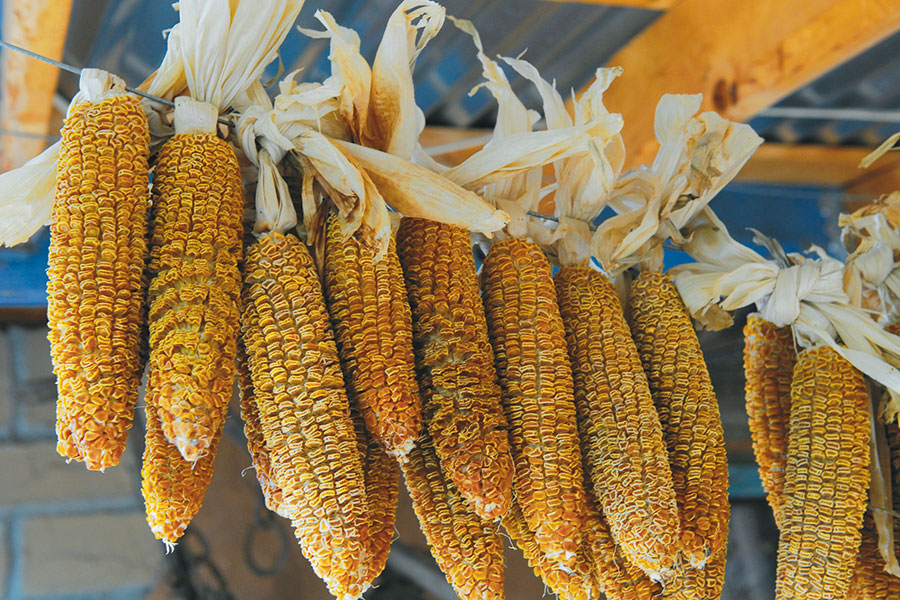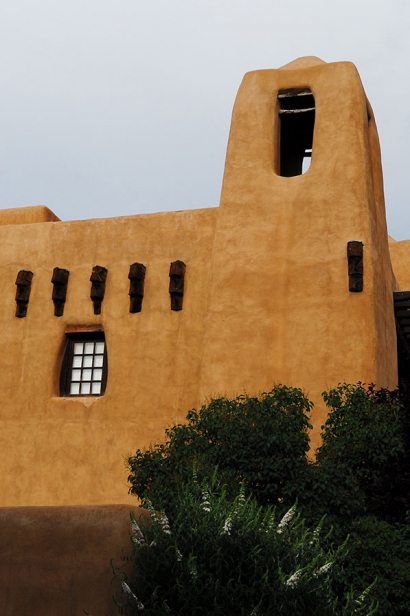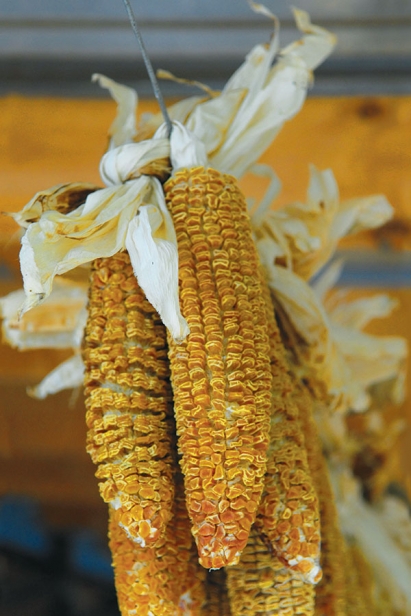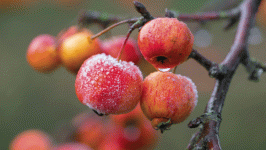Corn: Feeding the Stomachs and Souls of New Mexico
Pop quiz: If you had to pick one plant that represents and literally means life, fuel and happiness across the world and is planted on every continent except Antarctica, what would it be?
Corn. While its generally overlooked in spite of—or due to—its omnipresence, the humble plant deserves more than a cursory glance. Unassuming though it may be, it is the staple of diets and talisman of religions. The grain, plant and/or vegetable (depending on whom you ask and how it’s prepared), corn has shaped human civilization as we know it. Yet few places on earth still properly laud its essential role in our foodways and cultural customs. One exception is New Mexico. Corn was first domesticated by indigenous people in Mexico about 10,000 years ago. It has come a long way since: More than 88 million acres of corn worth roughly $49 billion were planted in the U.S. alone, according to the National Corn Growers Association’s latest numbers.
Little of that is destined for our plate, and of the fraction that arrives there, much of it comes in the form of high-fructose corn syrup. Much of those 88 million acres is grown to feed farm animals, to be converted into ethanol, even to be transformed into bio-based plastics. It’s an incredibly high-yield, easy-to-grow, versatile crop with enormous potential.
Corn’s most laudable attributes have also served to undermine its essence, renowned author Betty Fussell, who literally wrote the book on corn (The Story of Corn, University of New Mexico Press, reprinted in 2004) tells Edible.
“Corn is thought of as a commodity by most people these days,” Betty says. “That’s a shame, because it’s so much more. One of the few places where corn still means what it meant 10,000 years ago is New Mexico. It isn’t just grown there; it’s part of their life and, sometimes, their religion. New Mexico is one of the last places on earth, and certainly in this country, where corn is celebrated as a food and a religion. It’s pure magic.”
I know what she means. There is an ineffable air of mystery, strength, a rootedness in the land and the people in New Mexico, that’s hard to pin down but impossible to ignore. A recent trip to New Mexico with my preschoolers, parents and husband reminded me of the phenomenal climactic, topographical, cultural, religious and racial diversity of America, epitomized by this one amazing state and, arguably, by corn itself.
Weaving through the cities, vertiginous mountain ranges, stark desert landscapes, Pueblo villages and unassuming towns, a pride of place and a connection to the earth is a common thread in the stunning tapestry that the people of New Mexico have woven for centuries, well before Europeans arrived. The material they use to weave the tapestry is corn silk, glinting in the pale yellow, dusty desert sun.
When most food lovers think of New Mexico, they think of the chile. Green chiles and red chiles are genuinely unique visual and gastronomic delights that quite understandably bewitch locals and visitors with their colorful fireworks display of flavorful pizzazz.
If chiles are the prom queens of New Mexican cuisine, corn is the class valedictorian. Quiet, decidedly lacking in glitz but harboring a wealth of inscrutable knowledge and power, all under her pale little husk.
Corn, Ms. Fussell explains, is undeniably a building block of the cuisine (posole, tortillas, blue corn pancakes, atole, chalupas, enchiladas, tacos, tamales, tostadas all depend on blue or yellow corn), but its role in New Mexico’s culture and life goes far deeper.
“To me, corn is everything,” Betty says, sounding unapologetically solemn. “Coming to understand the depth of its symbolic value to Native American cultures made me rethink my entire worldview. We are so used to modern America’s scientific language, the separation of church and state, rooted as we are in post-Renaissance philosophy. But researching corn, spending time with the people of New Mexico, it was like rediscovering the pre-Christian world. Their entire iconography was based on corn, and you can still taste, see and feel that today in New Mexico.”
Like most of us, Betty did not naturally gravitate toward corn. “My first exposure to corn was creamed corn in a can or cornmeal mush, which came in a bag,” Betty explains. “In the Depression, when I was a child, everyone lived on processed corn. There was very little fresh vegetables and meat.”
And when the post–World War II food revolution was launched via Julia Child, corn didn’t seem to belong in the emerging canon of haute American cuisine. When Betty first started writing about food for Country Journal, Wine, Food & the Arts, Food Arts and other publications, she says her goal was to celebrate regional American cook- ing. Only after publishing countless articles and books like Masters of American Cookery (Times Books, 1984), did Betty realize she’d left out the breadbasket.
“Whoops!” she laughs. “The coasts are the port of entry for immigrants, and often serve as the literal and figurative melting pot of American culture and food. But I wanted to celebrate the roots of food in the rest of the country. After eight years of travel and research across the world, I discovered that really the heart of American cuisine was born in the Southwest, and at its root, is corn.”
Thousands of years ago, as Native people emigrated to and built cultures in New Mexico, corn deities were worshipped and a variety of stories and creation myths cropped up around them. In New Mexico, the corn goddess Iyatiku was worshipped by the Keresan people, a Pueblo group.
Today, and in fact since the 16th century, tourists flock to Santo Domingo in New Mexico, an enchanting Pueblo village midway between Albuquerque and Santa Fe and a universe away from modern America. The Kewa Pueblo, also known as the Santo Domingo Pueblo, and other Pueblos that pepper the Rio Grande in New Mexico celebrate their Corn Mothers (a blue corn woman and a white corn maiden) at dances and festivals between May and September.
The Corn Dance is a beautiful, highly ceremonial public dance of celebration and life, accompanied by chants, drumbeats and costumes. Other rituals are kept private for residents of the Pueblo and this, Betty argues, is how the Pueblo people of New Mexico have managed to maintain a transcendent appreciation of nature and a deeply rooted sense of the value of terroir that has largely been excised from modern American life.
While we did not visit the Kewa Pueblo during the time of a corn dance (usually August 4), we could see upon stepping foot in the ancient village that the native Kewa people still live a life shaped by agricultural rhythms. Their culture and the many ceremonies they observe today, as generations before them did, celebrate the balance between people, nature and the cosmos.
The people of New Mexico have successfully cultivated and nurtured their agricultural heritage, embodied in corn, but it is still endangered. Mark Miller, often credited as being the founder of modern Southwestern cuisine (he opened the revolutionary Southwestern restaurant Coyote Café in Sante Fe in 1987), and a chef who takes a decidedly anthropological approach to cookery, believes that the future of corn is rooted in the past.
In a recent interview with economist and writer Tyler Cowen, he pointed out that there are more than 8,000 varieties of corn. North American Indians grew 400. Both Miller and Fussell fear that genetic modification and the monocultural practices that dominate modern corn farming are systematically, if unintentionally, breeding out diversity and flavor.
Those flavors are worth saving, they argue. Miller even goes so far as to claim that different strains of corn—blue, white, yellow, brown—can be appreciated and differentiated, much like wine.
Is a corn tasting in your future? I hope so.
To get a taste of New Mexico’s soul, check out the sidebar on classic dishes and launch an anthropological culinary dig of your own. As one transplant from New Mexico to the Capital District explains, cooking “real” New Mexican food is “really about embracing everyday food with locally sourced ingredients. Some of the higher-end restaurants may emphasize heirloom varieties and more specialized dishes, but I consider that a revisionist approach.”
When she misses true New Mexican cuisine, she always turns to the classic home-style dishes, most of which require blue corn, pinto beans and red and green chiles. She advises New York home cooks aspiring to New Mexican flair to shop locally and seasonally for ingredients that approximate what can be found there.
In the spring and summer in New York, corn at the farmers’ markets abounds, and growers are always eager to talk shop about the varieties they favor and why.
Cook traditional dishes with local ingredients. Add soul, an open heart and gratitude, and the spirit of New Mexico will, ta-da!, appear.
Magic.
WANT THE FLAVOR WITHOUT THE FLIGHT?
Here are some classic New Mexican corn dishes to try:
ATOLE: A hot corn and masa-based beverage. Often accompanies tamales.
CHALUPA: A corn tortilla fried into a bowl shape and filled with shredded meats or beans, often topped with guac and salsa.
ENCHILADA: A blue or yellow corn tortilla brimming with meat or cheese, then rolled or stacked and covered in more cheese and chile sauce. The stacked version is considered more classic in New Mexico.
FLAUTA: A tightly rolled corn enchilada.
POSOLE: A thick stew made from hominy corn, pork and chile.
TACO: A corn tortilla fried into a purse shape and filled with meats, cheese, beans and veggies.
TAMAL: Meat rolled in cornmeal dough, wrapped in corn husks, steamed and served with red chile sauce.
TAQUITO OR TAQUITA: A tightly rolled, deep-fried variant of the taco.
TORTILLA: A flatbread made primarily of unbleached white wheat flour and cornmeal; the ratio of flour to cornmeal varies depending on the cook and its intended use. New Mexico-style tortillas are thicker than tortillas in Texas or California.
TOSTADA: A corn tortilla fried flat and covered with meat, lettuce and cheese to make an open-faced taco-pizza.
READY TO FLY?
Can't Miss Stops in Sante Fe:
Eat at the Shed
Sante Fe was founded in 1609. The Shed is in a 17th-century building near the main plaza around which the city picturesquely sprawls. There isn’t a better place to soak up history, grab some authentic, bracing margaritas and dig into some posole and blue corn enchiladas. 113. E Palace Ave.
See the Georgia O’Keeffe Museum
One of the most significant, controversial and intriguing artists of the 20th century, Georgia O’Keefe is most known for her famous flower paintings, luminescent land- scapes, stark images of bones and dramatic images of the desert sky. Like her or not, her contribution to American modernism is undeniable. Aside to parents of young children: Unlike many other museums I’ve dragged my kids to, they were suspiciously well-behaved here, lulled into silence and fascination by her esoteric interpretations of the everyday. They still talk about it. 217 Johnson St.
Stroll through the Santa Fe Plaza
The Santa Fe Plaza at the heart of the city is a national historic landmark. In the style of traditional Spanish-American colonial cities, it consists of a central park with grass, trees and benches, a monument to the American Indian War, and a fabulous taco stand. The city square hosts numerous events, including the Fiestas de Santa Fe, the Spanish Market, the Sante Fe Bandstand and the Santa Fe Indian Market, and surrounding it are side streets bursting with restaurants, breweries, art galleries, the New Mexico Museum of Art, the stunning Cathedral Basilica of Saint Francis of Assisi, the Loretto Chapel, wineries, cafés, hole-in-the- wall clubs.... You get the idea.
Stay at the Inn of the Governors
Inn of the Governors pampers its guests with a complimentary (and delicious) Mountain Sunrise Breakfast, a daily Tea and Sherry Hour with freshly made and highly addictive crispy butter cookies flavored with anise and cinnamon called Biscochito at 4pm, a heated outdoor swimming pool and an award-winning in-house saloon called Del Charro. Rates start at about $140 a night. InnoftheGovernors.com
Visit a pueblo
There are 19 pueblos in New Mexico, including the Eight Northern Indian Pueblos north of Santa Fe. Each pueblo is different, with separate nations, tribes and events. SantaFe.org is a great resource for information on the distinctive history and current culture of each Pueblo, plus up-to-date calendars of events and celebrations.








